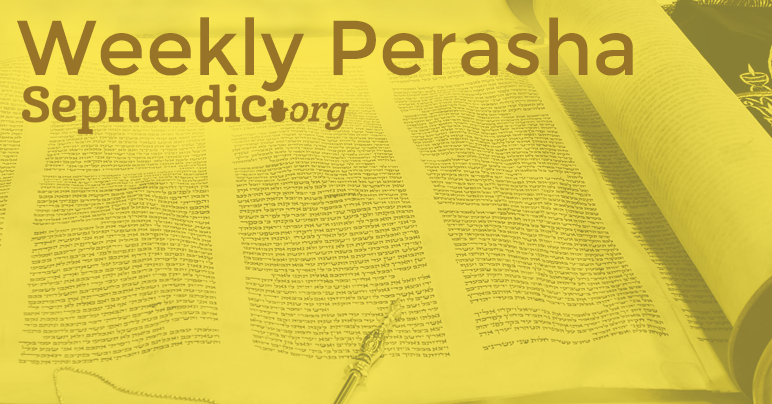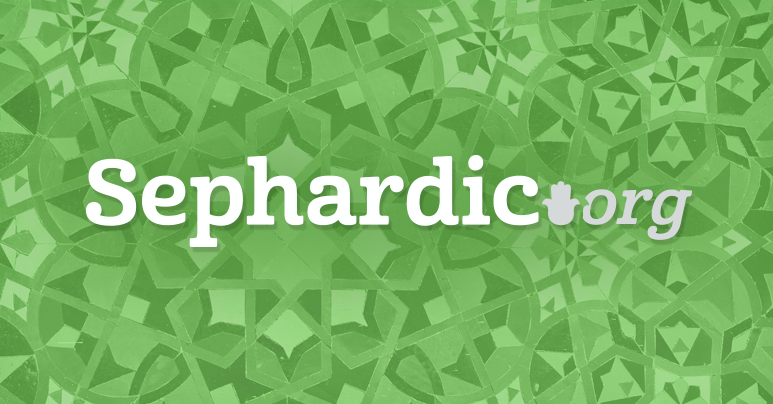
SAV - THE REDEMPTION OF HITAH (WHEAT) AND SPEECH (22 LETTERS)
The liturgical tradition of the Sepharadim places the Mizmor of Thanksgiving, Tehillim 107, at the forefront of the tefilot on the holiday of Pesah. 1 This which provides us a window into the festival is amplified by the Talmud that cites this Pereq as the source requiring Israel to give thanks on four specific occasions. They are - one who passes thru the sea, one who passes thru the desert, one released from prison and finally one who recovered from illness. 2 The commentators note that this relationship of the Mizmor to Pesah is that Israel were indeed saved from all four during the exodus from Egypt and hence are essentially obligated to offer a Thanksgiving sacrifice. 3 In our Parasha, the Torah details the four types of grain offerings that were to accompany the Todah animal offering. These consisted of three kinds of Masah and one kind of Hames breads. A portion of which were given to the Kohen with the balance to be consumed by the end of that night by the offerer and his family. 4 Following this path one can assert that the Seder ceremony on the first night of Pesah represents somewhat of a prototypical Todah offering to God. If so, we can now appreciate the Dutch R. Shaul Lowenstam’s interpretation (Hagadah) of the child's question posed to his father at the Seder. On all other nights while eating the accompanying breads of the Todah - it consists of both Hames and Masah - why on this night do we only have before us the three breads of Masah? Where is the Hames portion that is required to accompany the Todah eating ceremony? 5
CONNECTING THE TODAH OFFERING WITH PESAH
There are a number of similarities between the Korban Pesah and Todah. The most glaring is the obligation that both must be eaten by that night together with Masah. The ruling for the former is found in Parashat Bo - Eat the sacrificial meat during the night..eat it with Masot. 6 The latter can be found in our parasha Sav - A Todah offering which is to be presented along with Masot breads. 7 The Pesah lamb was unique in that it was offered by groups rather than individuals. The Talmud relates that there was not a single Korban Pesah that did not have a minimum of ten people registered for it. 8 Likewise every Korban Todah culminated in a communal meal. Parenthetically when today we can no longer bring a Todah we (instead) are required to recite Birkat HaGomel publicly in front of ten. 9 The offerer was required to consume parts of the offering along with 27 of the 30 loaves of Masah, and 9 of the 10 loaves of Hames. He would thereby invite his family and the Levi of his community to the communal meal in Jerusalem. 10 This conforms with the requirement that man must publicly acknowledge God's intervention in his personal fate. The Mizmor of Thanksgiving which doubles as the Mizmor of Pesah opens up - "Give thanks to Hashem...those redeemed by Hashem." 11 This is an integral part of the Seder which represents a pure expression of gratitude to God. Our obligation during both is to verbally thank God accompanied by the Masah.
REDEMPTION OF SPEECH - PESAH AND TODAH
As a result of the sin of Es-HaDaat - Dibour which is revealed via the the 22 letters of the Aleph Bet were concealed. This is the secret in that Moshe was Kaved Peh. It is only in the midst of the Ge’ulah do we learn Az Yashir Moshe 12 - Only then at the time of redemption does Moshe sing - Similarly one who is saved from danger is also the beneficiary of the redemption of Dibour from its husk. It appears to me that the Mizmor clearly reveals that the thanks offered for being saved is a Tiqun from the caused exile of the Es-HaDaat. This is expressed in verses towards the conclusion of the Psalm. "Let them give thanks to Hashem for his kindness and his wonders to the children of Adam (HaRishon). Let them slaughter Todah offerings and relate his works with joyful song." 13
REDEMPTION OF WHEAT -
The Talmud relates in the name of R. Yehuda that the Es HaDa’at was of wheat. 14 The consumption of which caused evil to become integrated within all wheat. In order to consume the staple, Adam would have to work to remove negativity. The Zohar considers two husks associated with Hitah- wheat. One being Mos or chaff as a verse in the opening chapter of Tehillim reads "Not so the wicked (evil husks) - they are like a chaff that (only) the Ru’ah - spirit drives away. 15 The other being Teven - or straw. Both have no connection with holiness and are therefore free from Ma’aser. - The first two letters Het Tet of Hitah - spelled with the three letters Het Tet Heh - represent these husks - The Zohar makes the point that these letters are therefore not found in the names of the twelve tribes. The final letter Heh represents the holiness within -(5 hasadim). 16 As a result of sin - Adam and his descendants will only be able to access holiness within the Hitah via a spiritual sweat of their brow. 17 We should thereby be able to assert that Hitah that is made into bread - represents to some extent the redemption of holiness called Tov from the Aram which attached itself to Es HaDa’at of wheat.
RELATIONSHIP BETWEEN THE HITAH (WHEAT) AND SPEECH
We have already noted earlier that the numerical value of Hitah equaling the 22 letters. We already mentioned the relationship between Hitah and Da’at - We can now begin to appreciate the Talmudic teaching of R. Yehuda that a child's development of speech coincides with the consumption of Dagan or purified Hitah. He teaches that a young child does not know - or attains the Da’at of how to call his father and mother until he tastes grain. 18 Mystically this means that when one consumes purified Hitah - it is a sign that he has ascended to a purified state of Da’at - namely one associated with Tov and not Ra. - This is the spiritually exalted state of Da’at - as it stands between the upper channels of Hokhmah coded in the Talmud as one’s father and Binah coded in the Talmud as one’s mother. He is homiletically saying that when Daat frees itself from evil then speech is freed from exile as well.
PESAH - ONLY THE INTIAL STAGE OF REDEMPTION
The "child's" question is now taking shape. We must see this seder as if we are leaving Egypt. The tree of Es HaDa’at is now exclusively Tov - the 22 letters associated with speech and Hitah have been freed! If the Seder represents a form of Todah - then not only Masot should accompany the thanks but even the Hames breads. Why is this night different from others - with the fourth Hames bread being absent and not being on the table with the three Masot. Furthermore if we say as do our Sages that the three Masot represent humility - then this can conform with the naming of Le’ah with each of her first three sons. She expressed a sense of humility with the name at each birth - My poverty, I am hated, my husband will now be joined with me. It is only after her fourth son Yehuda that she brings the equivalent of a Todah and says HaPa’am Odeh Et YHVH. Finally expressing her Thanks! 19 The answer is that Pesah represents only the initial stage of redemption. That equivalent to the three unleavened breads and first three sons of Le’ah. We know that Israel was initially on the 49th level of impurity - We were redeemed out of the kindness of the Creator and were placed on parole during the days of the Omer. 20 Evidently redemption is still incomplete - it is dependent upon additional sifting of evil that is attached to Hitah. - While Masah epresents the concept of Hipazon - when we are forced to limit any progression of evil - God is needed to intervene and make sure that the "Dog" doesn't bark. 21 The Hitah transformed into Hames without any fear of negativity is reserved for Shavuot - when Israel thru it's merits will stifle evil and earn complete redemption. This is when the bread loaves of Hames are finally offered in the Temple. The Bati Le’armoni explains the different spiritual planes of Israel during Pesah and Shavuot using the following analogy. There are three levels of processed grain - the Sadiqim or righteous are associated with Solet -fine flour; the Benoni or average ones with Qemah - regular flour; finally those still attached to wicked are associated with Subin -coarse bran. 22 Hence the child himself admits to the still admittedly low spiritual plane of Israel on the night of the Seder and says HaLayla Hazeh Kulanu MeSubin. 23 On this night we are all still as Hitah that is unrefined and we have not as of yet cleansed ourselves of evil. Our freedom this night exists solely out of the kindness of Hashem and hence we can only have Masah - We will have to pass thru and ascend during the Omer towards Shavuot when the Torah tells us in Emor Shene Esronim Solet Tihiyena Hames Te’aphena - two tenths of Solet (related to righteousness or the removal of evil) then it can be baked as Hames. 24 On Shavuot we can experience the complete redemption from evil and offer the loaves of Hames. - This idea was told to Moshe at the initial mention of the redemption - Vezeh Lekha Ha’ot Ki Anokhi Shelahtikha Behosi’akha Et Ha’am Mimisarayiim Ta’avdoon Et HaElohi”m Al HaHar Hazeh 25 - Only at Sinai (Shavuot) will the Ot or twenty two letters of Hitah be redeemed. Hence the child will have to wait until Shavuot to see the redemption elevated to see the Hames loaves join up with the three Masot present at the Seder.
Shabbat Shalom
Victor Bibi








